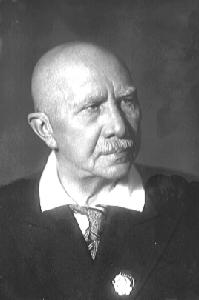presents a detailed summary of:
TWO DEATHS - by Aleksandr Serafimovich
(1926) Moscow. October 1917.
Moscow. October 1917.A tsarist cadet moves along the rooftops and fires down into Soviet Square, killing incautious passers-by.
A young woman appears in the Moscow Soviet and announces that she wants to help the revolution by spying on the cadets. A comrade with a Mauser in his belt sternly warns her that if she deceives them, the Reds will shoot her; and if the Whites find out that she is a spy, they (the Whites) will shoot her. She still insists on undertaking the mission. They give her a Red pass and a false document stating that she is the daughter of an officer living on Pokrovka.
She passes the Red checkpoint, showing her Red pass, which she then hides as she moves into White territory. Cadets surround her and take her to their academy-headquarters. She says her father died in the war with the Germans and that her two brothers are in Cossack detachments. She volunteers to work as a nurse. The cadets accept her and give her tea.
One of the cadets puts on the shabby clothes of a worker they've just killed, including his jacket with a bullet hole in the chest. He then sets out to Pokrovka to verify her story. There he finds a ragged citizen who confirms that just such a bourgeois woman lived there. She's been gone since that morning...maybe she was arrested.
Back at the academy, the cadets coming off duty crowd happily around the woman. They give her sweets, play songs on the piano, and present her with flowers. They also promise to get rid of that boorish horde of Reds. They tell her that they are planning an attack on the Smolensk market soon.
The next morning, on the way to the infirmary, the woman is shocked to notice a worker in a pink cotton shirt, lying dead on the ground in front of a white wall, a bullet hole in his head. "A spy," a cadet tells her.
She spends the day bandaging wounds, and on the second night says she has to go home to look in on her sisters. The cadets offer to give her an escort, but she refuses. On the way home, she loses her way in the dark, passing a burning building.
She is startled by a guard who aims a rifle at her and shouts, Who goes there? It's a Red, but in her confusion, she accidentally gives him her White pass. The guard looks at it upside-down. He's illiterate. So she just tells him she's going to the Soviet. He gives her directions.
At the Soviet, she tells them what she's learned about the Whites' plans, and the Reds are grateful for the information.
The next day, she returns to the cadets' academy. The attack on the Smolensk market is a disaster. The cadets suffer heavy casualties. The woman works tirelessly binding wounds and caring for the injured. Then a cadet, in his worker's disguise bursts in. He points at her and shouts out, "The whore! She betrayed us!"
The woman shouts back, "You're killing workers! I don't know how to use a gun, so this is how I kill you!"
The cadets take the woman out, stand her up in front of the white wall and put two bullets in her heart. She falls to the ground on the exact same spot where the worker in the pink shirt lay earlier. As the cadets drag away her body, her unflinching eyes stare into the stern and stormy October sky.
 Serafimovich, Alexander. Alexander Serafimovich
Popov (aka Serafimovich), a genuine Don Cossack, was born on
19 January 1863 in the village of Nizhne-Kurmoyarskaya, 100 miles east
of Rostov-on-Don. At age three, he and his family moved to Poland
with his father, who was stationed there with a
Cossack regiment. In 1874, they returned to the Don and settled in
Ust-Medveditskaya (later renamed Serafimovich).
Serafimovich, Alexander. Alexander Serafimovich
Popov (aka Serafimovich), a genuine Don Cossack, was born on
19 January 1863 in the village of Nizhne-Kurmoyarskaya, 100 miles east
of Rostov-on-Don. At age three, he and his family moved to Poland
with his father, who was stationed there with a
Cossack regiment. In 1874, they returned to the Don and settled in
Ust-Medveditskaya (later renamed Serafimovich). 